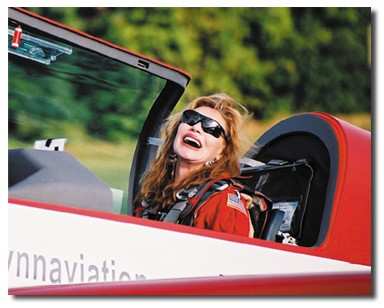NTSB Posts A Prelim On The Nancy Lynn Investigation
 NTSB Identification:
NYC07FA007
NTSB Identification:
NYC07FA007
14 CFR Part 91: General Aviation
Accident occurred Saturday, October 14, 2006 in Culpeper, VA
Aircraft: Extra Flugzeugbau GMBH 300, registration: N168EX
Injuries: 1 Fatal.
This is preliminary information, subject to change, and may
contain errors. Any errors in this report will be corrected when
the final report has been completed.
On October 14, 2006, about 1300 eastern daylight time, an Extra
Flugzeugbau GMBH 300, N168EX, was destroyed when it impacted
terrain at Culpeper Regional Airport (CJR), Culpeper, Virginia. The
certificated commercial pilot was fatally injured. Visual
meteorological conditions prevailed, and the airplane was not
operating on a flight plan. The local air show flight was being
conducted under 14 CFR Part 91.
According to a Federal Aviation Administration (FAA) inspector
who had been attending the show, the pilot had been performing
aerobatic maneuvers for about 6-7 minutes along runway 04-22 when
the accident occurred. At the time of the accident, the pilot was
performing "multiple snap rolls on a 45-degree down line," and
during the maneuver, the inspector heard the announcer state that
the airplane was in "the fourth turn of a five turn demonstration."
The inspector also noted the altitude of the airplane in reference
to the ground and shouted "NO", as he "did not believe the aircraft
could make another turn and clear the ground."

Another witness observed the airplane "descending rapidly
straight towards the ground at a point approximately 1/3 of the way
down runway 22." He estimated that it was "approximately 30-40 feet
agl [when] the pilot attempted to pull out of the downward angle
and regain level flight."
A third witness noted that the pilot "was just about to finish
her maneuver when she seemed to be accelerating towards the
ground." He "only caught the last few seconds, [but] noticed that
she snapped the wings level and contacted the ground (grass area
east of runway 22) on all three wheels, a 3-point landing." The
airplane "continued on the grass and it seemed that the right wing
started to lift, then the aircraft started to tumble..."
A fourth witness "[became] concerned that the airplane seemed to
be very low when the rotations stopped. The airplane stopped
rotation but was still descending and angled slightly towards the
runway. There was a quick roll to the left and pitch up shortly
followed by the left wing impacting the ground. I believe the
airplane cartwheeled once before going out of sight as there is a
ground depression on the other side of the runway."
A review of video footage revealed that the airplane (file
photo, below) completed two left-turning rolls at an approximately
45-degree descent angle, but during a third roll, the trajectory
changed toward a vertical descent. Following that, three additional
left rolls were also completed in an approximately vertical-descent
trajectory. After recovering from the last roll, the airplane
stabilized in an estimated 45-degree nose-down, 20-degree
left-wing-down attitude. The airplane continued to descend, and as
a distant tree line came into the camera's view, the airplane's
nose began rising, to where it was nose-level when the airplane
impacted the ground. The airplane then disappeared into a depressed
area behind the runway.

An examination of the accident site revealed a 950-foot wreckage
path that began about 200 feet to the east of the runway, then
continued along a general path of 240 degrees magnetic, and ended
at the main wreckage, about 50 feet from the runway's edge. Initial
ground scars along the wreckage path correlated to the airplane's
three landing gear and the left wingtip.
All flight control surfaces were accounted for at the scene.
Left wing remnants were found along the wreckage path, while most
of the right wing came to rest next to the main fuselage.
The main fuselage was on its right side at the time of
examination; however, witnesses reported that it had initially come
to rest inverted and was rolled to rescue the pilot. The fuselage
was charred in the cockpit area, and the only indicating gauge was
the altimeter, which was set at zero feet.
Flight control continuity was confirmed from the cockpit to the
rudder and elevator.
The propeller was shattered, and there was no evidence of
mechanical engine failure. Video footage also revealed constant
engine power throughout the accident sequence.
The airplane had been inspected by FAA personnel prior to the
air show for currency of inspections and any visual defects, none
of which were noted.
Weather, reported at an airport 20 nautical miles to the
northeast, at l253, included clear skies, visibility 10 statute
miles, winds from 280 degrees true at 11, gusting to 16 knots,
temperature 57 degrees F, dew point 25 degrees F. The wreckage was
subsequently moved to a storage facility in Clayton, Delaware.
 ANN's Daily Aero-Linx (04.16.24)
ANN's Daily Aero-Linx (04.16.24) Aero-News: Quote of the Day (04.16.24)
Aero-News: Quote of the Day (04.16.24) Airborne 04.10.24: SnF24!, A50 Heritage Reveal, HeliCycle!, Montaer MC-01
Airborne 04.10.24: SnF24!, A50 Heritage Reveal, HeliCycle!, Montaer MC-01 Airborne 04.12.24: SnF24!, G100UL Is Here, Holy Micro, Plane Tags
Airborne 04.12.24: SnF24!, G100UL Is Here, Holy Micro, Plane Tags Airborne-Flight Training 04.17.24: Feds Need Controllers, Spirit Delay, Redbird
Airborne-Flight Training 04.17.24: Feds Need Controllers, Spirit Delay, Redbird





